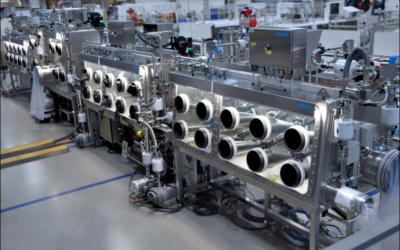Perovskite-Info weekly newsletter
Published: Tue, 11/29/22
The Perovskite-Info newsletter (November 29, 2022)
Cannot read this? View it online here
Researchers develop new perovskite-based approach for blue quantum dots synthesis and analysis
Researchers from The University of Tokyo and Yamagata University have addressed the difficulty in creating blue quantum dots by developing a unique self-organizing approach for producing lead bromide perovskite quantum dots. The research also incorporates cutting-edge imaging technology to characterize these novel blue quantum dots.
Quantum dots (QDs) are used in optoelectronic devices and quantum computing, among other things, and are referred to as "artificial atoms" due to their confined and distinct electronic properties. Quantum dots have characteristics that fall in between those of bulk semiconductors and individual atoms and molecules. Their photoelectric qualities vary depending on their size and shape. Quantum dots (QDs) are considered attractive materials for the emissive constituent of light-emitting diodes (LEDs) due to their high color intensity in a small spectral region, facile color tunability, and notable stability. Moreover, QD-based materials exhibit refined colors, longer lifetimes, reduced production costs, and lower energy requirements compared to typical luminescent materials used in organic light-emitting diodes (OLEDs).
Qcells joins European team in new project to promote perovskite-silicon tandem cell commercialization
South Korea-based Qcells and a European research group (led by Helmholtz-Zentrum Berlin (HZB)) have jointly established a pilot manufacturing line for silicon-perovskite tandem cells in Thalheim, Germany. The project aims to speed up the technology’s mass manufacturing and market penetration. The project began on 1 November.
The so-called "Pepperoni project" will establish a pilot manufacturing line in Thalheim, Qcell’s headquarters in Germany. The name stems from the broader project titled ‘Pilot line for European Production of PEROvskite-Silicon taNdem modules on Industrial scale' or PEPPERONI.
Researchers develop perovskite-based way to control optical signals
One of the main advantages of halide perovskites is their availability and ease of production. They are also characterized by the stable bound state of an electron and an electron hole that makes up an exciton. By connecting an exciton to light in a photonic crystal plate, researchers from Russia's ITMO University and the UK's University of Sheffield were able to reach record optical nonlinearity values, which makes the plates a promising tool for controlling optical signals and, in the future, can render them useful in optical computers.
Condensed matter physics describes, among other things, exciton-polaritons, which are special states in materials caused by a strong connection between light and matter, a photon and an exciton. Excitons are positively charged quasiparticles that result from a bound state of electrons and electron holes; these particles can freely move in a semiconductor. When the bound electron and electron hole “fall” onto each other, the exciton annihilates, emitting a photon with the exciton’s resonance energy (frequency).
MBraun to support Sungkyunkwan University in building new application lab and promoting perovskite research
MBraun, a major mechanical and industrial engineering company and an affiliate of Germany’s Indus Holdings AG, plans to invest almost USD$750,000 (1 billion won) in a South Korean university as part of a deal to jointly conduct solar cell-related research and development projects. MBraun will also donate research equipment to Sungkyunkwan University and help it build facilities for the projects. With the investment, MBraun and Sungkyunkwan University’s Advanced Institute of Nano-Technology (SAINT) will establish an application lab at the research center in Suwon, Gyeonggi Province.
“Korea is the birthplace of technological innovation. That’s why we decided to donate research equipment to a Korean university,” Patrick Bieger, MBraun’s chief executive, said in a recent interview with The Korea Economic Daily in Seoul. He said it’s the first time that MBraun has decided to invest in a university, which shows how important the Korean market is in terms of technological innovations.
Researchers develop lanthanides-based perovskite nanocomposite materials
Researchers from the Indian Institute of Technology (IIT) Jodhpur, India have developed a series of perovskite-based catalysts capable of efficiently producing hydrogen under ambient conditions. The end application of this research could be in the automotive and energy sectors, according to the statement issued by IIT Jodhpur. The developed catalysts are lanthanides-based perovskite nanocomposite materials for artificial photosynthesis. In the patented method, the researchers have used natural sunlight to convert water into hydrogen and oxygen, using a recyclable catalyst based on low-cost, simple transition metal.
The research team screened over 100 catalyst combinations to develop five sets of catalysts that gave high hydrogen production under sunlight. The catalysts work for wastewater, saline water and brackish water. They are recyclable and can be used multiple times. Lanthanide-based catalytic systems gave the best results and were found effective in continuous pure hydrogen production for 7.5 hours.
Metalgrass LTD
9 Har Tsin St.
Kfar Sava Hasharon 4430809
ISRAEL
Unsubscribe | Change Subscriber Options





